
Contents
|
Introduction
Design & Construction
The Hardware
An Operator's Experiences
Later Modifications
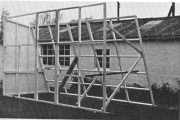 |
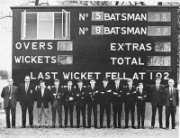 |
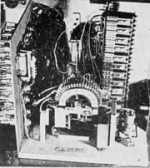 |
| The Framework | Scoreboard and Builders | One of the 'cubes' |
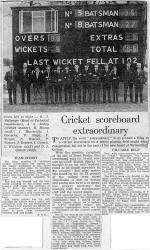 |
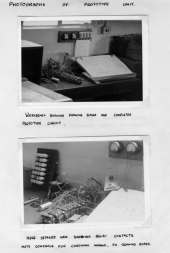 |
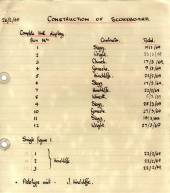 |
| Newspaper article | Prototype Unit (4 photos) | Construction assignments |
In the 1960s, throughout England, cricket scores were displayed customarily by means of simple mechanical arrangements, or just numbered tiles hung on a board. In the summer of 1969, cricket teams visiting Wymondham College were flabbergasted to see an enormous structure, replete with electronic digital displays - the like of which most had never seen before!
The scoreboard came about as a result of the introduction of a new 'A' Level subject - 'Elements of Engineering Design.' John C. Hinchliffe decided on an electronic scoreboard for his core project and, after examining a similar structure at Trent Bridge, developed a design that was based on electromechanical components of the type employed in older automatic telephone exchanges. At that time, the General Post Office (GPO) (later British Telecom) was replacing this 'Strowger' equipment with more modern technology, so surplus switches, relays and uniselectors were not too difficult to come by.
The course itself required documentation of a complete design, rather full development and production, so additional resources were assembled under the direction of Dave Goman and Andrew Seeley to manufacture the final article. The scoreboard was declared operational at commencement of the 1969 Summer Term but, because of exceptionally high rainfall and poor drainage in that area of the Park, it wasn't until after half-term that the scoreboard came into service.
The full production team comprised:
|
Staff:
|
Pupils:
|
Ian Gomeche: It was indeed a novelty having an electronic cricket scoreboard at a school, particularly when the electronics consisted of state of the ARK ex-Post Office relays and uniselectors. I should know - I helped to build the thing! Mr Seeley got all the Radio Club types, people just like me in fact, who fancied skiving off games to construct the thing from a design by John Hinchliffe (part of his Engineering Design course).
-
Francis Wright and I helped to build it and Colin Farrington later maintained it (I think I struggled with it for 3 seasons; 72,73 and 74 - Colin).
-
Ian Gomeche's dry joints were redone by Francis Wright.
-
Bill Slegg's only claim to fame was that he married the attractive McAvoy junior (McTavish senior aka Janice is on page facing 37 of 'The First 50 Years' book in a tennis team; 3rd from left, looking quite tasty. [Oi! You're digressing! - Ed.]
-
Peter 'Pook' 'Dropsy' Weaver used to get the piss taken for being a goody-goody two-shoes, but as he went to Cranwell and is now presumably 'Squadron Leader' Weaver, hurtling about in a Tornado (perhaps he is in the Red Arrows, God forbid) the boy done good after all. [See note below - Ed.]
-
Can't remember anything at all about Nicholas Winnicott and J. Roberts.
-
Ian Church always was really tiny.
I think it was 'Daish' Goman who had the contact in the Post Office (they did the UK's phone network in those pre-BT days), from where we got all the ancient electro-mechanical stuff from (relays, uniselectors etc.). We each autographed the numbers we had made, little one foot wooden cubes, so I am sure there are still some there with my monograph on them. We had a hell of a job experimenting with different combinations of bulbs and filters to make the thing actually visible in bright daylight. You can see the problem of glare and reflections in the picture.
When I spoke to Mr Seeley on the phone last year, for the first time since I left, he recalled that I had helped build his damn scoreboard and we discussed it at some length. He told me he is now making a living selling electronic scoreboards around the world. Hopefully his electronics are a bit more up to date than ours were!
Francis Wright: I think it was you (Ian) who kept reminding us all of the need for "good mechanical joints". No - not making sure the dope doesn't fall out before lighting, but wrapping the wire around the tag before soldering! John Hinchliffe was a bright guy. I wonder what he's doing now. Probably find he's the lead engineer with Palm Inc. or something similar! [Currently working as Head of IT at a company in Huddersfield - Ed.]
Moira Scott (Greenlee): I was just reading your stuff on the cricket score board. Peter Weaver went to Cranwell and did well in the RAF. He didn't have a flying job tho' - despite achieving an air cadet flying scholarship - and came out of the RAF quite early. I have an aerial picture of Wycol c.1972 taken from a plane piloted by Peter.
Brian Ellis: That scoreboard. I remember it well! I was briefly a member of the Radio Club and was given the task of de-soldering wires from the GPO selector units whilst Francis et al configured them for the job. More importantly - helping with the job of painting said scoreboard proved to be one of the best ways of "skiving off" from Sunday afternoon walks.
"The further you make the paint go, the better the job" - quote from EMOD (Mr Seeley). I'm surprised he didn't bid to take the white elephant in Greenwich off the hands of the tax-payer, for nothing, and convert that into a mega EMOD residency!
Ian Gomeche: 'The First Fifty Years' says that there were 28 bulbs to make each number - wrong! There were 26; two were 'missing' from the grid as they weren't required. Studying the picture carefully .... although I would rather study the pic on the next page of Kay Handel in her short tennis dress. I must say Janis McTavish has a very impish smile & looks very Bjork-like in fact [you're at it again! - Ed.] ..... anyway, back to the boring old scoreboard. The pic confirms a 7 by 4 grid. I know that the relays handled mains voltage, as I remember the very thick black wires to the relays and the round 3 pin socket in the back. I suppose there could have been a transformer in there.
The uniselectors we used were semicircular like the top half of the London Eye, but not quite as big! They were about 4-5 inches in circumference and the rotor spun in the vertical plane . they were about 3 inches wide, with zillions of contacts in banks of about 10-15 approx. By stripping big looms of wires in plastic sheathing, also from the GPO, we got loads of thin wires (with multi-coloured stripes) for the uniselector connections. I remember we stripped down both relays and the uniselectors, or at least some them. There was one uniselector per box (number) and about a dozen relays in a vertical stack, or perhaps 2 vertical stacks which would make more sense (1 per bulb). Thin wires were soldered to the uniselector contacts and went to the relays, which switched the mains voltage through to the bulbs.
Colin Farrington: The bulbs were 240v 'pygmy' lamps, but there was a transformer running at I believe 24v which was the voltage that the uniselector and relays operated at, with the relays switching 240v to turn the bulbs off and on. I remember there was an odd relay in there - something to do with switching of the middle bar to overcome figure 8 and figure 3 problems if I remember rightly.
The relays were in a vertical stack of about a dozen; each one switching a bank of bulbs that made up the numbers. The Uniselectors were as Ian describes them. I think there were 25 contacts round the unit, as I seem to remember that the numbers were doubled and could go through the sequence twice. There were I believe 10 banks - I know when we tried the redesign (see later) we used 7 banks for the elements of the numbers and one bank for switching.
I was involved in servicing it for the 72, 73 and 74 seasons. By that time, with storage over winter in a side room of hut 27, the relays had become a devil to get working correctly in the spring!
Francis Wright: That all sounds more plausible than my ramblings. Ian has also corrected my grid size to 4x7 (I think). Perhaps I underestimated the funds available when I proposed 3x5 or whatever it was. But here's a question: why were GPO relays capable of switching 240V? I thought telephone circuits ran at about 55V DC. Maybe they were not really capable of 240V. Did you have trouble with the contacts burning? Perhaps car headlight bulbs running at 12V would have been a better design - too late now, I guess!
Colin Farrington: Maybe the relays did run at 55v. All I can remember is there was a transformer that supplied the uniselector and relay control voltages. Mains supply ran through the contacts and bulbs. When we got to the stage in 1973/4 when we had insufficient working relays to get all boxes running, we had even pressed Hinchcliffe's original project box into service by this time.
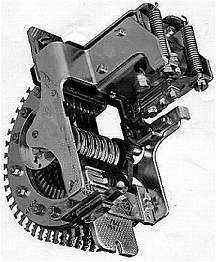 A GPO Type 2 Uniselector |
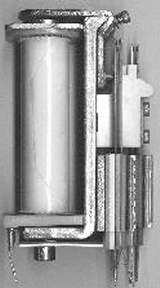 A GPO Relay (type 3000) |
Photographs are reproduced
by kind permission of John Chenery, webmaster of Light Straw ATE GPO components were once a vital part of the UK telephone service. For more details, travel back in telecoms time by visiting the Light Straw ATE site at: |
The only plus was the fact that it got me out of games on Wednesday afternoons nearly all year, as we were still blaming dry joints :-). My Wednesday mornings in the summer term in the sixth form were normally spent down in the scoreboard attempting to fix the broken boxes ready for the match that afternoon.
I remember one Wednesday I had one of those intermittent faults that you can never find. I was just fiddling and checking, when I saw a loose earth wire, so I got hold of it ... then started shaking! The fuse holder was broken, making the chassis plate live and someone had disconnected the earth wire to stop it blowing fuses! I was sitting there taking the full 240v. It was the only time I was grateful that the box had been built from chipboard which was acting as a damn good insulator!
We redesigned a box running mains voltage through the uniselector and using a 7 segment design (à la calculator) for the display and not a relay in sight. Seeley was NOT happy with the new look of that number and it was tucked away as "wickets fallen" as that was furthest from the other boxes!
As I mentioned earlier, the majority of the construction of the building was chipboard, with access to the scoring area by 5 or 6 steps. I got in the habit of jumping down them when I was in a hurry. One day we had a box fail on the 'total score' figure and as it was getting near the end of the match and scores were close, it was a rush to change it. I jumped down the steps and disappeared through the floor! The chipboard had given way, so we had to put extra nogging in the floor and replace an area of chipboard.
Grant Needham: I shared a dorm with Paul Webb... it was actually his idea for making the simpler "7 segment" displays after looking at his calculator. I then made the first simplified unit (in the lower 6 I think).
An Operator's Experiences (1974)
When I joined WyCol in 1969, the premium cricket pitch used by the First XI was equipped with a full size, electrically operated, score-box. All the score details were lit up electronically on square grids of light bulbs, instead of relying on people hanging numbered cards to indicate the scores. The operator would enter it by mounting some steps to the door, lock himself in and overlook the game in seclusion through a wide window, operating the controls to magically display the running totals, plus the target to beat if the other team had already batted. This score box was state-of-the-art technology at the time, having been designed as an 'A' Level project by an Upper Sixth former several years before. The school was justifiably proud of its score-box, as no other school had one; even most county cricket teams relied on the old fashioned cards, and the only other one I had ever seen was at Lord's.
By my fifth year in 1974, the score-box was still considered just as advanced as it had been in 1969, and all visiting teams marvelled at it. Although I was keen on cricket and quite a good batsman, my bowling let me down and I could never quite make the under-16's first XI. One of my classmates, Grant Needham (I believe from Kett Hall), had for a couple of years been delegated with maintaining the electrical circuitry of the score-box, being the only member of the extra-curricular electronics club. Knowing my fascination for gadgets, he suggested that instead of sitting on the under 16's reserve bench all the time, I should volunteer to operate the score-box for the school First XI. I jumped at the chance, and for many weeks enjoyed the prestige of being the guy in charge of the box. It also meant I could occasionally escape lessons if the First XI were playing (being the essential member of the school's sporting achievements that I was), and more importantly I could share the refreshments in the pavilion.
Then one day the school was to play a team from Diss. As usual I entered the box, and was surprised to find Grant already there. "Just checking everything", he explained, "We're ready to roll".
I switched on the power and made sure every display was reset to zero, revelling in the buzz and whirr of the machines (which Grant explained were called "servo's and stuff") as they responded to my effortless one-finger commands. I felt dozens of pairs of eyes admiring the newly lit-up displays which I felt I was responsible for.
The game started, and Batsman No. 1 scored one run. I clicked his dial once. Then batsman number 2 scored two runs. I clicked his dial twice. Then I noticed batsman number 2 having a word with the umpire and pointing at the score-box. The umpire, who happened to be Mr. ("Gut") Norton, a big man not noted for his patience and understanding, yelled something at me whilst waving his arms in my direction (I couldn't hear because of the window).
"What's wrong?" I asked Grant. "Maybe the first ball was a wide or something", he said. I clicked up one wide and added one to the total, hoping that would do the trick. It didn't; the umpire went ballistic! Beginning to panic, I checked the controls - but everything was as it should have been.
"Hey, of COURSE it wasn't a wide, or he'd have held his arms apart," said Grant. "It must have been a no-ball - quick, change it!" I began to wonder exactly how much Grant knew about cricket, but hurriedly changed it anyway, and looked up to see the umpire purple-faced, striding resolutely towards the score-box with murder in his eyes.
I completely lost it - "HELP; WHAT CAN I DO?" .... "CHANGE OVER BATSMAN 1's SCORE WITH BATSMAN 2's!" ... "WHAT"?? ..... "THE DISPLAYS ARE REVERSED! Number 1 is showing number 2's score! Swap them over!"
Things couldn't have got any worse, and I only had a few seconds to live anyway, so I swapped the scores. Surprisingly, the umpire stopped in his tracks, shook his fist at me and went back to the game. I drew crossed arrows in pencil on the console, reminding me to always add the runs to the guy's total who didn't actually score the runs. "Phew! That was close! Lucky you were here, I would never..." Then I twigged - I had been set up with a practical joke! The only way for Batsman 1's score to be shown as Batsman 2's score and vice-versa was if the connections had been deliberately reversed. "You complete ba...." I started, whirling around but finding that Grant was nowhere to be seen. Needless to say, I discreetly skipped the refreshments that afternoon and was never allowed near the score-box again.
David Cook
I notice a mention of Grant Needham; I trained him up as my replacement in 1974. It sounds as if he pulled some of the stunts on his replacement that I pulled on him - swapping box leads etc. I never took it on myself to add the runs as I saw them, I always had the 2 "book" scorers up there with me. I only added runs etc. as they put them in the official scorebook, then if they were wrong it wasn't my fault :-)
Colin Farrington
Around 1974 to 1976 Peter Martin led a team of us (mainly day pupils) who were crap at sports and who Andy Seeley decided were better at scoreboard 'module' maintenance. Pete's idea was to do away with most of the driving electronics which were inherently unreliable, and drive the bulbs directly from the uniselectors, using the main 50 Volts. Over the next two years we re-wired all modules instead of running around in shorts in the wet.
Andy Warman